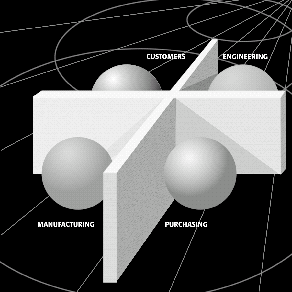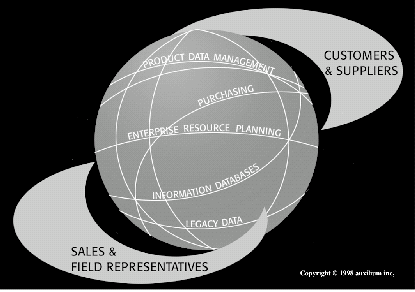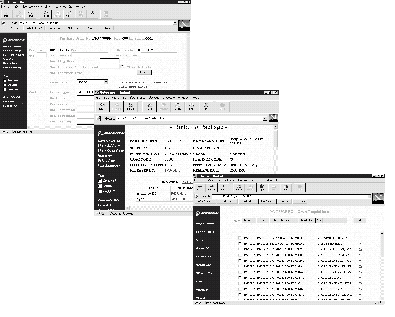

Time-to market pressure has been with us since Henry Ford started rolling his first black Model T's off the assembly line. Today it is a critical focus for process improvement as well as technical and management innovation. In response, many manufacturing companies have made significant progress by introducing process re-engineering, adding new application software, computerizing additional functions, and deploying new technology in the manufacturing process. We've done a good job at improving personal productivity of the individuals who participate in the product development lifecycle, but any gains are limited by the fact that manufacturing delivery continues to be a serial process, not a truly concurrent work process that enables collaborative work tasks.
We can view the manufacturing process as a pipeline of information: information is created, consumed and analyzed within a function and then flows on to the next function. To date, any cycle-time improvement has been based on improving the capacity or performance of an individual function. Ironically, improving the productivity of a single department (planning, for example) has increased the degree of specialization of both the data and the user, and it has actually made it more difficult to effectively share information with other departments.
Today, engineering and planning systems do not work together efficiently; and incorporating customers in the manufacturing delivery process rarely occurs except in B-school case study discussions. Managers know that to improve time-to-market any further, we need to facilitate concurrent, rather than serial, communication. Beyond that, we also need to facilitate the sharing of information on a much broader basis, linking people who previously didn't have access to it. The concurrent availability of information among all job functions will reduce cycle-times dramatically.

But that level of integration has proved very costly both in terms of capital and human resources. First, 70%-80% of manufacturing data exists on mainframes, and often that information is proprietary. There is no cost-effective way to access the data; the hardware and software development costs to facilitate concurrent communication in a manufacturing delivery system continue to be a serious barrier to integration. And, once a data user has access to the hardware, the specialized interfaces for various functions impose yet another restraint. People in planning need to know design application programs to get the information they need, and customers need to know it too. Historically, most software used was not designed for broad distribution and usage across departments, because it was written for the creators, rather than the consumers of data. So, the overall capacity of manufacturing systems today continues to be constrained by the transfer of information among functions.
A Technological Breakthrough--the WWW
The advent of the World Wide Web has brought about several exciting technological breakthroughs that are making it possible to approach enterprise-wide interoperability, the time-to-market Holy Grail. Organizations have begun to deploy internet technologies for use within the enterprise.
The use of web browsers reduces hardware costs drastically, since data consumers can use everyday tools (PCs, laptops, mobile computers and workstations) to locate information across widely dispersed networks. Putting such a simple tool on each employee's desk provides access to data and information located throughout the enterprise and to any other locations linked by the World Wide Web.
Web technology is also relatively easy to scale and expand as the network's integrated information resources proliferate and user workloads grow. Because of the internet's universal TCP/IP and HTML standards, using the web as an applications platform solves a headache for large distributed applications: interoperability. Because intranets are based on the same independent standard internet protocols and technologies, they are accessible to every member within an organization, regardless of their choice of hardware platform.
Directory structures developed for internet use, and their underlying standards, are available to provide user information to control access to applications and databases, which facilitates delivering information on a need-to-know basis. This role-based access of information is one of the key elements of intranet architectures. The system can now appear to each user as a vast source of information, accessible through a consistent interface. If the information needed to support all processes is also available throughout the system as it is created, process-time improvements increase exponentially. Using these web-based technologies lets us design intranets that reduce process complexity and improve information access.
Intranet servers enable real business functionality such as publishing information, processing data and database applications, and collaboration among employees, vendors, and customers. Across all industries, intranets are rapidly reshaping company-wide communication, collaboration, productivity, and innovation - and saving significant time and money in the process. Corporate intranets can provide information in a way that is immediate, cost-effective, easy to use, rich in format, and versatile.
Leveraging Web Technology in the Manufacturing Environment
Web technology lets us change the way individuals in different departments or roles perform their specific function. No longer limited to merely creating data, people are able to access and manipulate data in various systems, allowing them to become data consumers. Since the data users and their inability to communicate concurrently have historically been the bottleneck, this solution is a paradigm shift that has implications for exponential productivity improvement.

Leveraging web technology is based on empowering data consumers. Employees must be empowered to work smarter, not harder. In today's ever-changing business environment, giving the corporate end-user, or data consumers, the ability to find, access and utilize corporate data assets easily and transparently within the existing intranet, creating a generation of knowledge workers, is the means to optimizing individual and enterprise productivity.
Let's look specifically now at improving the distribution of technical information and the ability to connect remote plants, customers and suppliers throughout an enterprise. Boeing has been contracted by the Air Force to create the next generation of Global Positioning System (GPS) satellites. As part of the contract, Boeing is required to make a large number of documents available on-line. To do this properly, the company realized the need to link employees, customers and eventually suppliers throughout the enterprise. Using web-based technology they have enabled users working on GPS II to simultaneously share information such as program specs and engineering drawings, comment on them, and then sign off. Once the items are ready for release, everyone can access and use them immediately.
The benefits to Boeing went beyond the documentation requirements. First, the training time for end-users was significantly reduced. Web pages tailored to the data consumers' specs and business processes were quickly generated, resulting in an intuitive GUI that was easily understood and accepted. Finally, as a result of the other benefits, development costs were minimal.
Another leverage point for cycle-time improvement is role-based access to information. The traditional focus on data creation hasn't solved the need for information access across the company. The best-in-class system used in one department is not necessarily easy-to-use for the infrequent user who needs a small subset of the information generated. And because there are many different systems, the user is often burdened with the need to log into each one and deal with different methods and interfaces to retrieve information. Confusion and frustration levels increase, and users tend to turn to less efficient ways to get information--old fashioned phone calls or sorting through stacks of reports.
Rocketdyne Division of Boeing has implemented a web interface to their Procurement-D system, a purchasing module of MACPAC/D, a mainframe-based MRP system. This simplifies the integration of Product Data Management (PDM) and Enterprise Resource Planning (ERP) applications and legacy systems. Now, for example, a purchasing person can easily access engineering and manufacturing data without having to know how to operate the specific PDM or ERP applications.

Finally, delivering information on a need-to-know basis is another leverage point in improving cycle time. Sweden's telecommunications giant, Ericsson, is a good example of how an intranet can be effectively used to deploy a PDM (Product Data Management) system. Ericsson's goals were simple: reduced time-to-market and customer, global information access, and an efficient workplace. The Ericsson Data Group, which has 2,000 employees worldwide, is the corporation's first unit to successfully launch a PDM system. They were charged with offering information technology required to help Ericsson Corporate design and prepare products for final production. To accomplish this they adapted a commercially available PDM system to create a Project Data Library (PDL) and provide a platform for both local and global development projects and libraries.
A product development team of 140 people was split between two continents. When the two product teams began using the PDL as a base for the project, they also allowed project managers to access their documentation within the product information infrastructure. This allows a team on one continent to develop software during their regular workday, then, later, as workers from another time zone begin their workday, the newly generated documentation and changes to existing data are already available at the click of a mouse or the push of a button. This is truly concurrent access to design data and information.

A Vision of Enterprise-wide Interoperability
Enabling enterprise-wide interoperability has great potential for reducing cycle times and streamlining business processes across the organization. Consider that we already have proven web-based technologies and products to deliver the promise of interoperability today. Where do we go from here? We will begin to see communication among applications, and to move in the direction of complete electronic commerce (the ultimate involvement of the customer). As the human interaction/communication is reduced, so too will be learning curves and training, further improving cycle-time. The business impact will be shortened cycle-times and reduced development costs, which adds up to flexibility. And that's the key to staying competitive in today's environment.
But Can You Get There from Here?
Every organization has the pressure to reduce time-to-market, whether it comes from competitors breathing down your neck or significant customers looking over your shoulder, but where do you start?
Upper Management. To implement any major change whether technical or cultural (and this involves both) you need an operations team with a vision. Your job will be to act as a "change agent" and help the team develop a vision for total process integration. Facilitate meetings with other executives who have made similar changes and benefited from them. As you begin your research on solutions, have your operations team meet with vendors to begin to give them an idea of the possibilities. As a parallel activity you should also begin to develop a "proof-of-concept" which involves the following steps:
Technology Team. This team should be working closely with the operations team on the business problem and be involved in developing the proof-of-concept.
As companies attempt to address the needs of large numbers of users throughout the enterprise, they must address the fact that users in various departments view data differently. Sales and marketing are driven by sales order numbers, engineering by part numbers, manufacturing by job number and customers by model and catalog numbers. Beyond these key data elements, however, all users have a common interest in other information components such as manufacturing schedules and delivery dates, current revision levels, costs, ad technical specifications and drawings. Many current information systems do not allow users to easily access information. By leveraging intranet technology to integrate disparate information sources, linking departments throughout the enterprise, organizations are able to manage the flow and distribution of information throughout the manufacturing supply chain.
Providing interoperability throughout the supply chain improves productivity, reduces cycle times, and increases margins. That’s the bottom line.

About the Author
Michael R. Viola is a founder and CEO of auxilium inc., a leading supplier of intranet-based software used to integrate engineering, planning, and factory floor information in support of improved manufacturing. Michael is a software start-up veteran with more than twenty-five years of experience in technology marketing and product development. Early in his career he was a manufacturing engineer for the Sperry Corporation and a manufacturing engineering manager for the Owatonna Tool Company (OTC) where he was instrumental in improving manufacturing processes that provided a 50 % reduction in past due manufacturing orders, an 80% reduction in quality costs, and a threefold increase in inventory turns. These improvements were largely responsible for OTC’s being recognized as one of the 10 best manufacturing companies in the United States in the mid-1970’s.
Recognizing that applying computer systems to manufacturing would be a necessity to continue advancements in manufacturing techniques, Mr. Viola went to work for Control Data Corporation where he directed commercial CAM software development activities; later he directed a staff of over 100 people in the development of the entire CAD/CAM product.
Michael’s background in manufacturing technology, user-oriented problem solving, product development, and business management has prepared him for his current focus on the application of web-based technologies and products used to impact and optimize process control in support of improved manufacturing.